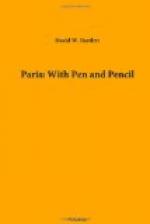On my return home I passed through a street often mentioned by Eugene Sue in his Mysteries of Paris—a street formerly noted for the vile character of its inhabitants. It was formerly filled with robbers and cut-throats, and even now I should not care to risk my life in this street after midnight, with no policemen near. It is exceedingly narrow, for I stood in the center and touched with the tips of my fingers the walls of both sides of the street. It is very dark and gloomy, and queer-looking passages run up on either side from the street. Some of them were frightful enough in their appearance. To be lost in such a place in the dead of night, even now, would be no pleasant fate, for desperate characters still haunt the spot. Possibly the next morning, or a few mornings after, the stranger’s body might be seen at La Morgue. That is the place where all dead bodies found in the river or streets are exhibited—suicides and murdered men and women.
Talking of this street and its reputation in Eugene Sue’s novels, reminds me of the man. When I first saw it he had just been elected to the Chamber of Deputies by an overwhelming majority. It was not because Sue was the favorite candidate of the republicans, but he stood in such a position that his defeat would have been considered a government victory, and consequently he was elected. I was glad to find the man unpopular among democrats of Paris, for his life, like his books, has many pages in it that were better not read. At that time he was living very quietly in a village just out of Paris, and though surrounded with voluptuous luxuries, he was in his life strictly virtuous. He was the same afterward, and being very wealthy, gave a great deal to the poor. His novels are everywhere read in France.
I was not a little surprised during my first days in Paris to see the popularity of Cooper as a novelist. His stories are for sale at every book-stall, and are in all the libraries. They are sold with illustrations at a cheap rate, and I think I may say with safety that he is as widely read in France as any foreign novelist. This is a little singular when it is remembered how difficult it is to convey the broken Indian language to a French reader. This is one of the best features of Cooper’s novels—the striking manner in which he portrays the language of the North American Indian and his idiomatic expressions. Yet such is the charm of his stories that they have found their way over Europe. The translations into the French language must be good.
Another author read widely in Paris, as she is all over Europe, is Mrs. Stowe. Uncle Tom is a familiar name in the brilliant capital of France, and even yet his ideal portraits hang in many shop windows, and the face of Mrs. Stowe peeps forth beside it. Uncle Tom’s Cabin was wonderfully popular among all classes, and to very many—what a fact!—it brought their first idea of Jesus Christ as he is delineated in the New Testament. But Mrs. Stowe’s Sunny Memories was very severely criticised and generally laughed at—especially her criticisms upon art.




